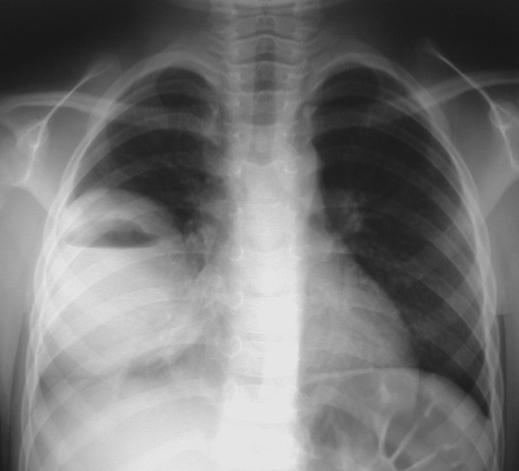2 min read - Pneumonia
A 75 years old female patient with diabetes mellitus, hypertension and ischemic heart disease presented with fever and cough for 3 days duration. She produced yellow color sputum, but there was no hemoptysis. There was right-sided chest pain on breathing. She had nausea and the appetite was poor.
What are the possibilities?
What are the possibilities?
- Fever, cough, sputum and pleuritic chest pain equals pneumonia unless proven otherwise!
- Many conditions can mimic pneumonia. Read and find out!
On examination the patient was ill-looking. She was tachycardic and tachypnoeic. Blood pressure was 100/70mmHg.
Respiratory examination revealed signs localized to the right lower zone.
- Reduced chest expansion
- Increased vocal fremitus
- Dull percussion note
- Bronchial breathing
- Increased vocal resonance
- Whispering pectoriloquy!
What do these physical signs mean? Read about physical signs and how to interpret them.
- A consolidation in the right lower zone.
With these findings, the clinical diagnosis of right lower lobe pneumonia was made.
Now, what should you do?
- Basic principles of managing pneumonia.
- Confirm the diagnosis
- Prompt initiation of correct empiric antibiotic
- Try to identify the culprit organism
- Identification and management of complications
- Management of comorbidities
- Assess response to treatment
- Once adequately treated, decide on the need for further investigations and follow up
Let's discuss about these aspects briefly
Confirmation of the diagnosis
- Clinical diagnosis is sufficient.
- Take a good erect PA Xray of the chest.
- Basic investigations like WBC, CRP will provide supportive evidence
Empirical antibiotic
- Before starting the antibiotic it's crucial to guess what the organism is.
- Organisms vary according to the place where the patient acquired the infection
- Common places are
- Community
- Hospital
- ICU
- Read the classification of pneumonia
- Learn 5 organism each which commonly cause the above types
- What are atypical organisms?? Learn the names of a few.
- As most patients we get are from the community, an appropriate combination of antibiotics would be
- 3rd generation cephalosporin (Like cefotaxime, ceftriaxone) + atypical antibiotic
- Beta-lactam (Coamoxyclav) + Atypical antibiotic
- BEFORE STARTING ANY ANTIBIOTIC - TAKE CULTURES!!!
Identify the culprit organism
- Various investigations can be done
- Blood culture
- Sputum culture
- Antigen tests (eg: legionella urinary antigen)
- What else?
Complications
- Sepsis and shock!
- Local complications
- eg: abscess formation, Pleural effusion, Empyema
 |
| Note the effusion (and the sternal wires!) |
 |
| Lung abscess |
- Other organ involvement
- eg: hepatitis, arthritis, glomerulonephritis, meningitis
- Systemic problems
- eg: SIADH
- The list goes on and on!! Read.
Comorbidities
- Carefully manage comorbidities
- eg:
- in diabetic patients its better to omit oral drugs and start on insulin
- antihypertensives may need to be omitted if the patients blood pressure is low
- Comorbid pulmonary diseases can adversely affect the outcome
- eg: Asthma
- Treat those aggressively
Response
- If you have treated well, within 48 hours the patient will clinically improve.
- If there's no improvement something somewhere has gone wrong. Reevaluate!
- See if the diagnosis is correct (it could be TB or cancer)
- See if the patient has developed a complication
- See if the antibiotic is right (is it viral pneumonia?)
- See if the comorbidities are well controlled
- If the response is good, continue antibiotics for total of 7-10 days. (Different units may have different policies)
- Discharge when the patient is stable.
Follow up
- Young otherwise healthy patients may not need to follow up.
- For others, a repeat Xray should be done by around 2 weeks.
- Xray changes can persist up to 6-12 weeks, or even longer.
- Persistent abnormalities in high-risk patients (eg: smokers) may indicate the presence of an underlying illness such as cancer.
Another important consideration!
- Influenza is common, young well patients tolerate it well.
- Elderly patients/ patients with comorbidities are at higher risk of developing severe disease.
- In those, if features are suggestive
- An epidemic is going on
- High fever
- Preceding upper respiratory tract symptoms
- Diarrhea
- Bilateral involvement in Xray... etc
- start oseltamivir (Tamiflu) as early as possible.
There's a lot more to talk about. Maybe on another day!



Thank you very much ayya !!
ReplyDeleteIt was very interesting & useful 💪💪💪
Thank u.
ReplyDelete